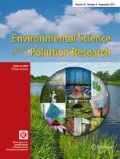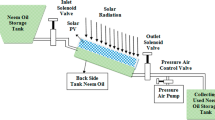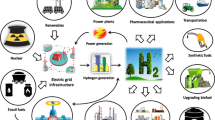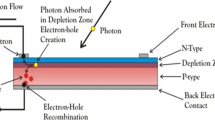Abstract
The present article focuses on a cradle-to-grave life cycle assessment (LCA) of the most widely adopted solar photovoltaic power generation technologies, viz., mono-crystalline silicon (mono-Si), multi-crystalline silicon (multi-Si), amorphous silicon (a-Si) and cadmium telluride (CdTe) energy technologies, based on ReCiPe life cycle impact assessment method. LCA is the most powerful environmental impact assessment tool from a product perspective and ReCiPe is one of the most advanced LCA methodologies with the broadest set of mid-point impact categories. More importantly, ReCiPe combines the strengths of both mid-point-based life cycle impact assessment approach of CML-IA, and end-point-based approach of Eco-indicator 99 methods. Accordingly, the LCA results of all four solar PV technologies have been evaluated and compared based on 18 mid-point impact indicators (viz., climate change, ozone depletion, terrestrial acidification, freshwater eutrophication, marine eutrophication, human toxicity, photochemical oxidant formation, particulate matter formation, terrestrial ecotoxicity, freshwater ecotoxicity, marine ecotoxicity, ionising radiation, agricultural land occupation, urban land occupation, natural land transformation, water depletion, metal depletion and fossil depletion), 3 end-point/damage indicators (viz., human health, ecosystems and cost increases in resource extraction) and a unified single score. The overall study has been conducted based on hierarchist perspective and according to the relevant ISO standards. Final results show that the CdTe thin-film solar plant carries the least environmental life cycle impact within the four PV technologies, sequentially followed by multi-Si, a-Si and mono-Si technology.









Similar content being viewed by others
References
Aulich HA (2006) PV industrial production. In proceedings from: 3rd PV industry forum at the 21st European Photovoltaic Solar Energy Conference, Dresden
Bilich A, Langham K, Geyer R, Hansen J, Krishnan A, Bergesen J (2017) Life cycle assessment of solar photovoltaic microgrid systems in off-grid communities. Environ Sci Technol 51:1043–1052
Brunner P, Rechberger H (2016) Practical handbook of material flow analysis. CRC Press LLC, Boca Raton, Florida
De Wild-Scholten MJ, Alsema EA (2005) Environmental life cycle inventory of crystalline silicon photovoltaic module production. Proceedings of the Materials Research Society, Boston
De Wild-Scholten MJ, Alsema EA, Ter Horst EW, Bächler M, Fthenakis V (2006) A cost and environmental impact comparison of grid connected rooftop and ground based PV systems. In: Proceedings of the 21st European Photovoltaic Solar Energy Conference, Dresden
Ecoinvent (2018) Ecoinvent version 3.5. As available in https://www.ecoinvent.org/database (accessed 2019)
Fthenakis V (2004) Life cycle impact analysis of cadmium in CdTe PV production. Renew Sust Energ Rev 8:303–334
Gerbinet S, Belboom S, Leonard A (2014) Life cycle analysis (LCA) of photovoltaic panels: a review. Renew Sust Energ Rev 38:747–753
Gibon T, Arvesen A, Hertwich EG (2017) Life cycle assessment demonstrates environmental co-benefits and trade-offs of low-carbon electricity supply options. Renew Sust Energ Rev 76:1283–1290
Goedkoop M, Heijungs R, Huijbregts M, Schryver AD, Struijs J, Van Zelm R (2013) ReCiPe 2008 Report I: characterisation (v 1.08), Amsterdam
Hauschild MZ, Goedkoop M, Guinée J, Heijungs R, Huijbregts M, Jolliet O, Margni M, De Schryver A, Humbert S, Laurent A, Sala S, Pant R (2013) Identifying best existing practice for characterization modeling in life cycle impact assessment. Int J Life Cycle Assess 18:683–697
Hesse K, Schindlbeck E (2004) Silicon for the PV industry. Wacker Chemie AG, Munich
Huang B, Zhao J, Chai J, Xue B, Zhao F, Wang X (2017) Environmental influence assessment of China’s multi-crystalline silicon (multi-Si) photovoltaic modules considering recycling process. Sol Energy 143:132–141
IEA (2018) Snapshot of global photovoltaic markets, Report International Energy Agency PVPS T1-33, Paris
ISO (2006a) International Standard Organization. Environmental management - Life cycle assessment - principles and framework. Reference number ISO 14040:2006(E)
ISO (2006b) International Standard Organization. Environmental management - life cycle assessment - requirements and guidelines. Reference number ISO 14044:2006(E), Geneva
Jungbluth N, Stucki M, Flury K, Frischknecht R, Busser S (2012) Life cycle inventories of photovoltaics. ESU-Services Ltd. Version 174-LCI-Photovoltaics-2012 (v 1.1), Zurich
Kabakian V, McManus MC, Harajli H (2015) Attributional life cycle assessment of mounted 1.8 kWp monocrystalline photovoltaic system with batteries and comparison with fossil energy production system. Appl Energy 154:428–437
Kim H, Kyounghoon C, Fthenakis V, Sinha P, Tak H (2014) Life cycle assessment of cadmium telluride photovoltaic (CdTe PV) systems. Sol Energy 103:78–88
Lamnatou C, Chemisana D (2015) Evaluation of photovoltaic-green and other roofing systems by means of ReCiPe and multiple life cycle based environmental indicators. Build Environ 93:376–384
Lieberei J, Gheewala SH (2016) Resource depletion assessment of renewable electricity generation technologies - comparison of life cycle impact assessment methods with focus on metal resources. Int J Life Cycle Assess 22:185–198
Mohr NJ, Meijer A, Huijbregts MAJ, Reijnders L (2013) Environmental life cycle assessment of roof-integrated flexible amorphous silicon/nanocrystalline silicon solar cell laminate. Prog Photovolt 21(4):802–815
Mustafa NI, Ludin NA, Mohamed NM, Ibrahim MA, Teridi MA, Sepeai S (2019) Environmental performance of window-integrated systems using dye-sensitised solar module technology in Malaysia. Sol Energy 187:379–392
Ozoemena M, Cheung WM, Hasan R (2018) Comparative LCA of technology improvement opportunities for a 1.5-MW wind turbine in the context of an onshore wind farm. Clean Techn Environ Policy 20:173–190
Photovoltaics Report (2019) Fraunhofer Institute for Solar Energy Systems. Fraunhofer Institute for Solar Energy Systems, Stuttgart
PRé (2019) Quantifying sustainability. As available in https://www.pre-sustainability.com/. (accessed in 2019)
Rashedi A, Sridhar I, Tseng KJ (2012) Multi-objective material selection for wind turbine blade and tower: Ashby’s approach. Mater Des 37:521–532
Rashedi A, Sridhar I, Tseng KJ (2013) Life cycle assessment of 50 MW wind firms and strategies for impact reduction. Renew Sust Energ Rev 21:89–101
Rashedi A, Sridhar I, Tseng KJ, Srikanth N (2015) Minimum mass design of thin tubular structures under eccentric compressive loading. Thin-Walled Struct 90:191–201
Tianqi L, Roskilly AP, Wang Y (2018) Life cycle sustainability assessment of grid-connected photovoltaic power generation: a case study of Northeast England. Appl Energy 227:465–479
Tsang MP, Sonnemann GW, Bassani DM (2016) Life-cycle assessment of cradle-to-grave opportunities and environmental impacts of organic photovoltaic solar panels compared to conventional technologies. Sol Energy Mater Sol Cells 156:37–48
Acknowledgements
We thank the comments of the anonymous reviewers that helped improve the article. We also thank Mirjam Jonkman for proof reading.
Funding
We like to acknowledge the research grant (grant reference no: 26181420; 2019) of Charles Darwin University for the financial support.
Author information
Authors and Affiliations
Corresponding author
Ethics declarations
Conflict of interest
The authors declare that they have no conflict of interest.
Additional information
Responsible editor: Philippe Loubet
Publisher’s note
Springer Nature remains neutral with regard to jurisdictional claims in published maps and institutional affiliations.
Electronic supplementary material
ESM 1
(DOCX 65 kb)
Rights and permissions
About this article
Cite this article
Rashedi, A., Khanam, T. Life cycle assessment of most widely adopted solar photovoltaic energy technologies by mid-point and end-point indicators of ReCiPe method. Environ Sci Pollut Res 27, 29075–29090 (2020). https://doi.org/10.1007/s11356-020-09194-1
Received:
Accepted:
Published:
Issue Date:
DOI: https://doi.org/10.1007/s11356-020-09194-1




